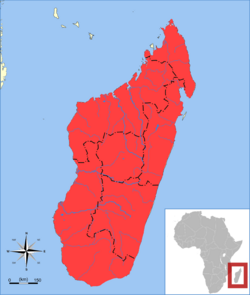Biology:Tailless tenrec
| Tailless tenrec[1] | |
|---|---|

| |
| Scientific classification | |
| Domain: | Eukaryota |
| Kingdom: | Animalia |
| Phylum: | Chordata |
| Class: | Mammalia |
| Order: | Afrosoricida |
| Suborder: | Tenrecomorpha |
| Family: | Tenrecidae |
| Subfamily: | Tenrecinae |
| Genus: | Tenrec Lacépède, 1799 |
| Species: | T. ecaudatus
|
| Binomial name | |
| Tenrec ecaudatus (Schreber, 1778)
| |

| |
| Tailless tenrec range | |
The tailless tenrec (Tenrec ecaudatus), also known as the common tenrec, is a species of mammal in the family Tenrecidae. It is the only member of the genus Tenrec. Native to Madagascar , it is also found on the Comoros, Mauritius, Réunion, and Seychelles island groups, where it has been purposely introduced.[2] Its natural habitat is the understory of subtropical-tropical forest, open forest, arid shrub-land, savanna, arable land, pastures, crop plantations, private gardens, and some landscaped, urban areas.[2]
The tailless tenrec is the largest species of the tenrec family, Tenrecidae. It is 26 to 39 cm (10 to 15 in) in length and weighs up to 2 kilograms (4.4 lb).[2] It has medium-sized, coarse grey to reddish-grey fur and long, sharp spines along its body. The animal is omnivorous and, unlike the herbivorous rodents for which it is often mistaken, possesses small, needle-like sharp teeth for a diet of larger invertebrates, frogs, reptiles, mice and other small mammals, as well as fruits, leaves and other vegetation.[3] If threatened, this tenrec will scream, erect its spiny hairs to a crest, jump, buck and bite. It shelters in a nest of grass and leaves under a rock, log or bush by day. It gives birth to a litter of as many as 32 young, with an average litter between 15 and 20 after a gestation of 50–60 days; when young, they have a black-and-white striped appearance. Despite being sometimes known as the tailless tenrec, they have a small tail 1 to 1.5 cm (0.39 to 0.59 in) in length.
The tailless tenrec was the first tropical mammal observed to hibernate, for long stretches of time without waking periods, up to nine months at a time.[4] The tailless tenrec is a host of the acanthocephalan intestinal parasite Promoniliformis ovocristatus.[5]
References
| Wikimedia Commons has media related to Tenrec ecaudatus. |
- ↑ Bronner, G.N.; Jenkins, P.D. (2005). "Order Afrosoricida". in Wilson, D.E.; Reeder, D.M. Mammal Species of the World: A Taxonomic and Geographic Reference (3rd ed.). Johns Hopkins University Press. p. 77. ISBN 978-0-8018-8221-0. OCLC 62265494. http://www.departments.bucknell.edu/biology/resources/msw3/browse.asp?id=11100049.
- ↑ 2.0 2.1 2.2 2.3 Stephenson, P.J.; Soarimalala, V.; Goodman, S. (2016). "Tenrec ecaudatus". IUCN Red List of Threatened Species 2016: e.T40595A97204107. doi:10.2305/IUCN.UK.2016-1.RLTS.T40595A97204107.en. https://www.iucnredlist.org/species/40595/97204107. Retrieved 19 November 2021.
- ↑ "Tenrec ecaudatus (Tailless tenrec)". https://animaldiversity.org/accounts/Tenrec_ecaudatus/.
- ↑ Gruber, K. G. (23 October 2014). "Mammals may have slept through dinosaur extinction". Australian Geographic. https://www.australiangeographic.com.au/news/2014/10/hibernation-key-to-mammals-surpassing-dinosaurs/.
- ↑ Dollfus, Robert-Ph.; Golvan, Yves-J. (1963). "Sur un singulier Métacanthocéphale parasite d'insectivores (Tenrecinae) de Madagascar et des Comores". Annales de Parasitologie Humaine et Comparée 38 (5): 793–806. doi:10.1051/parasite/1963385793. https://www.parasite-journal.org/articles/parasite/pdf/1963/05/parasite1963385p793.pdf. Retrieved February 9, 2020.
Wikidata ☰ Q852769 entry
 |


